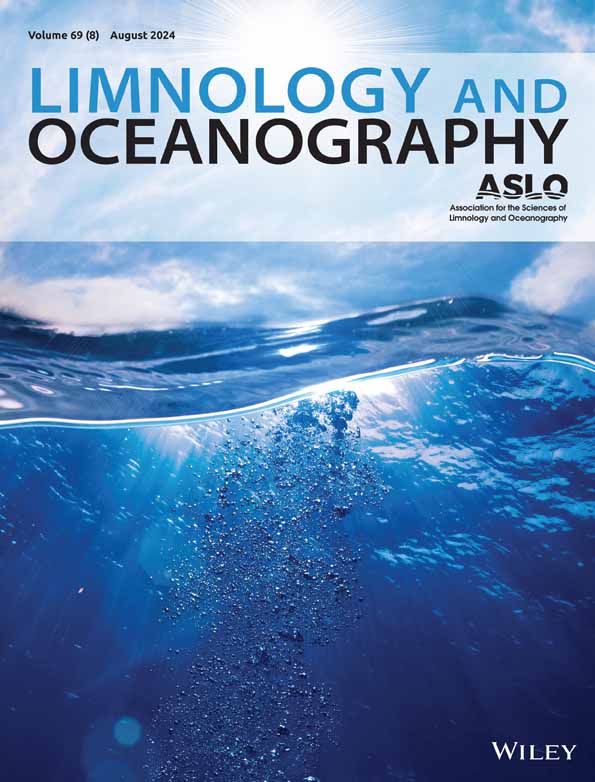不同城市淡水生态系统的二氧化碳排放量
IF 3.7
1区 地球科学
Q1 LIMNOLOGY
引用次数: 0
摘要
淡水排放的二氧化碳是全球重要的碳通量。然而,城市水域的二氧化碳通量仍然限制不足,在可靠地扩大规模方面仍然存在挑战,部分原因是城市水生生态系统的高度多样性。我们使用浮动室即时测量通量,并对其进行多日监测,估计了柏林市四个季节31个地点(湖泊、池塘、河流和溪流)的二氧化碳排放量。我们评估了土地覆盖、养分浓度、溶解有机质(DOM)组成、叶绿素a和微污染物浓度作为二氧化碳排放的潜在驱动因素。湖泊和池塘的二氧化碳通量平均为0.41 g C m - 2d - 1(不同地点和方法的范围为- 0.45至3.38),与以前的研究结果一致。来自我们城市河流和溪流的二氧化碳通量平均为0.78 g C m - 2d - 1(范围从- 0.13到7.32),低于通常报道的流水,可以想象,这可能是由于水道化低地系统中的气体交换有限。二氧化碳通量与DOM芳香性呈正相关,表明外来输入为呼吸提供资源,无论是来自(处理过的)废水还是密封的城市表面。在有利于初级生产的环境中,通量更低,变化更大,表明二氧化碳减少的影响。这种情况与铺砌面积的较高百分比相吻合。对整个城市的水生网络进行外推,得出的年排放量估计为8.8 g C‐CO2。本研究的一个启示是,在建立大规模的二氧化碳排放预算时,应将城市湖泊、池塘、河流和溪流视为不同的系统。本文章由计算机程序翻译,如有差异,请以英文原文为准。
Carbon dioxide emissions across contrasting urban freshwater ecosystems
Carbon dioxide (CO2 ) emissions from freshwaters represent a globally important carbon flux. However, CO2 fluxes from urban waters remain poorly constrained, and challenges remain for reliable upscaling, partly because of the high diversity of urban aquatic ecosystems. Using floating chambers to measure fluxes instantaneously and monitor them over multiple days, we estimated CO2 emissions at 31 sites (lakes, ponds, rivers and streams) across the city of Berlin in four seasons. We evaluated land cover, nutrient concentrations, dissolved organic matter (DOM) composition, and chlorophyll‐a and micropollutant concentrations as potential drivers of CO2 emissions. CO2 fluxes from lakes and ponds averaged 0.41 g C m−2 d−1 (ranging from −0.45 to 3.38 across sites and methods), aligning with the results of previous studies. CO2 fluxes from our urban rivers and streams averaging 0.78 g C m−2 d−1 (range from −0.13 to 7.32) were lower than typically reported for running waters, conceivably due to limited gas exchange in the channelized lowland systems. CO2 fluxes were positively associated with DOM aromaticity, pointing to allochthonous inputs delivering resources for respiration, whether from (treated) wastewater or sealed urban surfaces. Fluxes were lower and more variable in settings favoring primary production, suggesting an impact of CO2 drawdown. This condition coincided with a higher percentage of paved area. Extrapolation to the entire aquatic network of the city yielded an annual emission estimate of 8.8 Gg C‐CO2 . An implication of this study is that urban lakes, ponds, rivers, and streams should be recognized as distinct systems when establishing large‐scale CO2 emission budgets.
求助全文
通过发布文献求助,成功后即可免费获取论文全文。
去求助
来源期刊

Limnology and Oceanography
地学-海洋学
CiteScore
8.80
自引率
6.70%
发文量
254
审稿时长
3 months
期刊介绍:
Limnology and Oceanography (L&O; print ISSN 0024-3590, online ISSN 1939-5590) publishes original articles, including scholarly reviews, about all aspects of limnology and oceanography. The journal''s unifying theme is the understanding of aquatic systems. Submissions are judged on the originality of their data, interpretations, and ideas, and on the degree to which they can be generalized beyond the particular aquatic system examined. Laboratory and modeling studies must demonstrate relevance to field environments; typically this means that they are bolstered by substantial "real-world" data. Few purely theoretical or purely empirical papers are accepted for review.
 求助内容:
求助内容: 应助结果提醒方式:
应助结果提醒方式:


